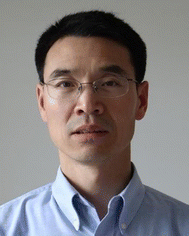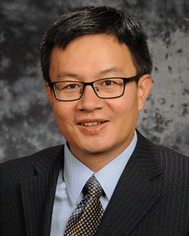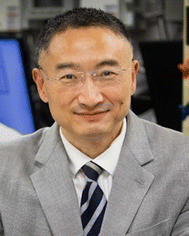DOI:
10.1039/D4MA90116A
(Editorial)
Mater. Adv., 2024,
5, 7847-7849
Introduction to ‘Conducting ceramic membranes for energy conversion and storage’

Kyle Brinkman
| Kyle Brinkman is the chair of the Department of Materials Science and Engineering at Clemson University in Clemson, SC. Kyle is a two-time Clemson graduate (BS Chemical Engineering 1998 and Materials Science and Engineering 2000) who returned to Clemson in 2014 after a global research career. He graduated from the Swiss Federal Institute of Technology in Lausanne, Switzerland, with a PhD in materials science and engineering. Brinkman then served as a postdoctoral fellow at the Advanced Industrial Science and Technology Institute in Japan as part of a program sponsored by the Japanese Society for the Promotion of Science and later worked as a principal engineer in the Science and Technology Directorate of the U.S. Department of Energy's Savannah River National Laboratory. He has published ∼120 journal articles, holds five patents and has authored and coauthored ∼150 presentations at national and international venues. He is a Fellow of the American Ceramic Society (FACErS), a Fellow of the Royal Society of Chemistry in the UK (FRSC), an Academician of the World Academy of Ceramics and a NETL ORISE Faculty Fellow, received the Brimacombe Medalist Award and the Young Leader International Scholar Award from The Minerals, Metals & Materials Society, the Navrotsky Award for Experimental Thermodynamics and the Karl Schwartzwalder-Professional Achievement in Ceramic Engineering (PACE) Award from the American Ceramic Society (Awarded to top Ceramic Engineer in Country, 40 or under). Professor Brinkman currently serves as the Editor of Journal of Materials Science and the co-director of Clemson's Center for Nuclear Environmental Engineering Sciences and Radioactive Waste Management (NEESRWM). |

Fanglin (Frank) Chen
| Fanglin (Frank) Chen is currently a tenured full Professor, Associate Chair and Undergraduate Director in the Department of Mechanical Engineering at the University of South Carolina. He received his BS in Chemistry (1992) from Anhui University, China, a MSc in Materials Science and Engineering (1995) from the University of Science and Technology of China, and a PhD in Materials Science and Engineering (2001) from the Georgia Institute of Technology (USA). He spent six years as a Senior/Staff Engineer and Task Leader working in the Solid Oxide Fuel Cells Program at the United Technologies Research Center (currently the RTX Technology Research Center) prior to his faculty appointment at the University of South Carolina in Fall 2007. Dr Chen was a Summer Faculty Fellow at the Air Force Research Laboratory (2009 and 2010) and at the NASA Glenn Research Center (2022). Dr Chen is a core faculty member of the South Carolina SmartState Solid Oxide Fuel Cell Center, leading materials development and electrochemical performance evaluation activities. Dr Chen's primary teaching responsibilities at the University of South Carolina are in the areas of engineering materials and fuel cell technologies. His research interests are in the area of materials design for solid oxide fuel cells, solid oxide electrolysis cells, and gas separation membranes. Dr Chen has authored/co-authored more than 250 peer-reviewed journal articles and holds 12 US patents in his research areas. Dr Chen has received several awards and recognitions, including the Great Job Award (2002 and 2007) and Outstanding Achievement Award (2005) from the United Technologies Research Center, the Rising Star Faculty Award (2010), the Young Investigator Award (2010), the Research Progress Award (2012), the Research Achievement Award (2016), and the Breakthrough Leadership in Research Awards (2019) from the University of South Carolina, and the South Carolina Governor's Young Scientist Award (2013). Dr Chen serves as the Chief Specialty Editor for Frontiers in Energy Research – Fuel Cells, Electrolyzers and Membrane Reactors, and Associate Editor for International Journal of Hydrogen Energy. Dr Chen also serves on the editorial board of Clean Energy and Ceramics. |

Dong Ding
| Dr Dong Ding is a distinguished staff engineer/scientist in the directorate of Energy and Environmental Science & Technology at Idaho National Laboratory, leading the electrochemical processing and electrocatalysis (EPEC) team consisting of >20 researchers. Dr Ding is a technical lead and steering committee member for two hydrogen related consortia: HydroGEN of the Energy Materials Network (EMN) and H2NEW under the U.S. DOE–Energy Efficiency and Renewable Energy (EERE)–Hydrogen and Fuel Cell Technology Office. Dr Ding is an executive committee member and secretary/treasurer for the High-Temperature Energy, Materials, and Processes (H-TEMP) Division of the Electrochemical Society (ECS). He served as an editorial advisory board member for Journal of Power Sources Advances, a guest editor for Frontiers in Materials, Frontiers in Chemistry, Journal of Physics: Energy and Journal of Materials Research. He was the recipient of the EES&T Mentor Award in 2024, the Lab Director Exceptional Scientific Achievement Award in 2022, the EES&T Leadership Award in 2021, the Asian American Most Promising Engineer of the Year in 2020, and Federal Laboratory Consortium (FLC) Far West Awards in the category of Outstanding Technology Development in 2019. Dr Ding holds joint/affiliated faculty positions at the University of Utah, University of South Carolina, New Mexico State University, and University of Idaho. Prior to joining INL, he was Sr Materials Engineer at Redox Power Systems in Maryland. Dr Ding received his doctorate in materials science at the University of Science & Technology of China (USTC), where he also earned a bachelor's in materials chemistry. Dr Ding has co-authored over 140 peer-reviewed publications and a book chapter. He also holds 12 US patents and 20 patent applications. Dr Ding's current research interests relate to INL's two mission initiatives: advanced design and manufacturing (ADM) and integrated energy systems (IES), including high-temperature water electrolysis, natural-gas upgrading, advanced manufacturing of solid oxide cells/stacks, CO2 capture and conversion, ammonia electrosynthesis, fuel cells, and electrocatalysis. |

Xiao-Dong Zhao
| Professor Xiao-Dong Zhou is The Nicholas E. Madonna Chair in Sustainability, Connecticut Clean Energy Fund professor in Sustainable Energy, Director of the Center for Clean Energy Engineering, and a Professor in Chemical and Biomolecular Engineering, Mechanical Engineering, and Materials Science and Engineering at the University of Connecticut. He is a special advisor to UConn President Radenka Maric in Sustainability. Dr Zhou received the J. B. Wagner Jr Young Investigator Award in 2007 from the Electrochemistry Society (ECS) – High Temperature Materials Division. He is the recipient of the 2011 US DOD – DARPA Young Faculty Award. He is a Fellow of the Electrochemical Society. His research interests span theoretical and experimental studies of materials and interfaces for energy systems, including batteries, fuel cells, and electrolyzers. |
Ceramic membranes that transport ions play an essential role in numerous energy conversion systems, including solid-state Li-ion batteries, proton and oxygen separation membranes, intermediate-temperature solid oxide fuel cells and solid oxide electrolysis cells,1 and partial oxidation of methane for natural gas processing.2 The operation of membranes in realistic operating scenarios may lead to changes in the phase formation, interfacial characteristics, and microstructure of material systems, thus affecting performance. With decreasing thickness of membranes aimed at enhanced transport, surface and interfacial effects become more important and can dramatically impact membrane performance.
The purpose of this themed collection is to provide a snapshot of current research in the field and highlight challenges and opportunities. The use of ceramic-based ion conducting membranes for a wide range of applications in energy conversion and storage is a challenging task; however, the research outlined in this collection contributes to an improved understanding of the fundamentals and new materials opportunities and approaches, while providing concurrent opportunities for early-career researchers to publish alongside established leaders in the field. This themed collection consists of 12 papers addressing the following primary topics:
• Li-based solid state batteries.
• Beyond Li conductors (Na, K).
• Protonic ceramic reversible fuel cells: electrolyte and anode/cathode electrode and catalyst design, cell components, cell design, reversible and dynamic operation, and testing.
• Oxygen–ion fuel cells and electrolysis cells, cell components, cell design, reversible and dynamic operation, and testing.
• Ceramic-based oxygen and hydrogen separation membranes and membrane systems for natural gas processing and upgrading.
• Computational materials science of ceramic ionic conductors.
Highlights include work by Sun et al. (https://doi.org/10.1039/d2ma01003h), who present a review linking structure with ionic conduction mechanisms for solid-state proton and hydride anion materials.
Zheng et al. (https://doi.org/10.1039/d3ma01167d) examine a triple oxygen, proton and electron conducting candidate material, PrNi0.7Co0.3O3, under dynamic operating conditions to investigate the degradation behaviors via novel accelerated stress testing.
Sozal et al. (https://doi.org/10.1039/d3ma00793f) fabricated patterned Ag electrodes on BZCYYb4411 proton-conducting electrolyte by photolithography and E-beam evaporation to characterize interfacial properties, leading to improved intermediate-temperature proton ceramic fuel cells (IT-PCFC).
Ishii et al. (https://doi.org/10.1039/d3ma00901g) present an alternative use of the popular solid-state ceramic-based Li-ion conductor LLZO as a potential proton-conducting solid-state electrolyte for fuel cells and electrolyzers.
Rowberg et al. (https://doi.org/10.1039/d3ma00308f) use computational methods to demonstrate that high ionic conductivity can be achieved through optimizing synthesis conditions to maximize the concentrations of interstitial protons in conventional BaZrO3 and BaCeO3 proton-conducting materials systems.
Fischer et al. (https://doi.org/10.1039/d3ma01095c) discuss work on a dual-phase composite 60 wt% Ce0.8Gd0.2O2-d–40 wt% FeCo2O4 (60CGO20–FCO) oxygen transport membrane (OTM) with demonstrated high levels of oxygen permeability. They discuss the stability and oxygen permeance related to mechanically and chemically stable compositions and an optimized microstructure.
We appreciate all authors for their submissions and interest in the themed collection and the reviewers for their comments and suggestions. We would like to thank the editorial staff of the Royal Society of Chemistry (RSC) for assistance putting together this themed collection and hope that the reader will enjoy this collection of articles highlighting current trends in the field of conducting ceramic membranes for energy conversion and storage.
References
- P. S. Gaikwad, K. Mondal, Y. K. Shin, A. C. T. van Duin and G. Pawar, npj Comput. Mater., 2023, 9, 149 CrossRef CAS.
- G. Chen, A. Feldhoff, A. Weidenkaff, C. Li, S. Liu, X. Zhu, J. Sunarso, K. Huang, X.-Y. Wu, A. F. Ghoniem, W. Yang, J. Xue, H. Wang, Z. Shao, J. H. Duffy, K. S. Brinkman, X. Tan, Y. Zhang, H. Jiang, R. Costa, K. A. Friedrich and R. Kriegel, Adv. Funct. Mater., 2022, 32, 2105702 CrossRef CAS.
|
| This journal is © The Royal Society of Chemistry 2024 |
Click here to see how this site uses Cookies. View our privacy policy here.  Open Access Article
Open Access Article *a,
Fanglin (Frank)
Chen
b,
Dong
Ding
*a,
Fanglin (Frank)
Chen
b,
Dong
Ding
 c and
Xiao-Dong
Zhou
d
c and
Xiao-Dong
Zhou
d




